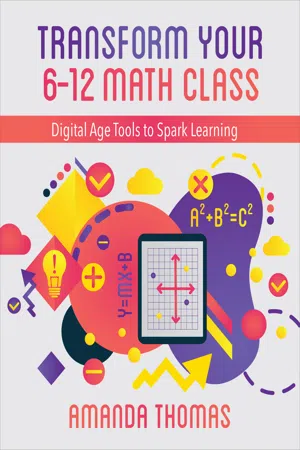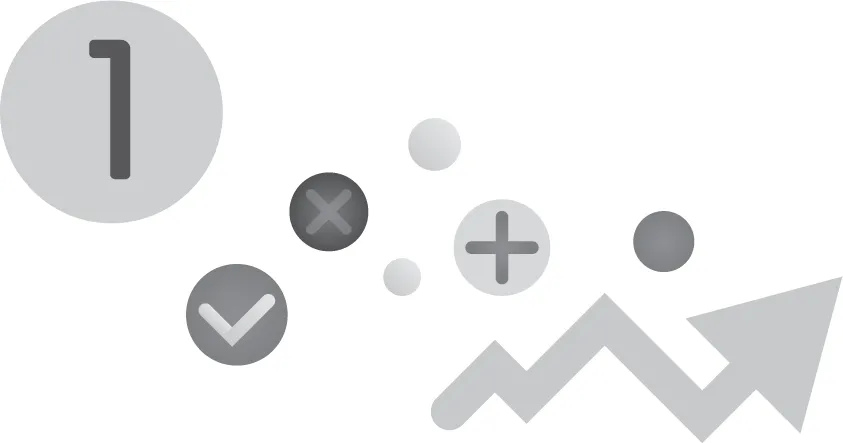CONSIDERATIONS AND CHALLENGES FOR INTEGRATING TECHNOLOGY IN MATH TEACHING
How technology is integrated into one’s teaching practices
is connected to the models of teaching and approaches to
learning that are employed.
THIS CHAPTER INCLUDES overviews of relevant considerations and challenges for integrating digital tools into math instruction in Grades 6–12. These considerations and challenges include a working definition for school math as a socially-constructed endeavor, including equity and access to cutting-edge technology, 1:1 technology initiatives, curriculum resources, and personalized learning. The chapter concludes with a discussion of standards that frame technology and math in secondary classrooms.
What Is School Math?
To many, math is a set of numbers, symbols, formulas, and rules. Others might think of school math in terms of subtopics such as arithmetic, geometry, algebra, and statistics. Mathematicians tend to focus on such things as patterns, structure, logic, proof, modeling, and abstractions. Math content standards have defined specific math learning expectations, as well as standards for math practice that articulate mathematical ways of thinking.
Math Learning Is a Socially Constructed Endeavor
When we interpret math proficiency as a combination of procedures, concepts, strategies, reasoning, and disposition, developing math proficiency becomes more complex than numerical problems with multiple-choice answers. Traditional models of teaching math have included teacher-centered classrooms where students sat in rows of desks, listened and watched dutifully as the teacher demonstrated how to carry out a procedure, practiced the procedure with the teacher as a class, and then completed independent practice exercises that mimicked what the teacher modeled. This paradigm of instruction is sometimes referred to as gradual release, or I do, We do, You do, and tends to align with behavioristic transmission of knowledge from teacher to student.
Equity and Access to Technology and Math
It is not enough for some, or even most students to learn meaningful math and to have access to educational technology. Patterns of inequities disproportionately impact girls, children with special needs, and students from racially, ethnically, and linguistically diverse backgrounds, depriving them of rich learning opportunities. For example, diverse students tend to be overrepresented in “low” math tracks where they are too often met with low expectations and procedurally focused math that is not built on a foundation of conceptual understanding. Here, too, there are often fewer resources and less-experienced teachers.
1:1 Technology Initiatives
Student access to technology devices can be a major barrier for technology integration in math, or any subject. Many schools have been gradually transitioning from dedicated rooms for computer labs to mobile computer/tablet carts, and other options. Recently, we’re seeing more 1:1 devices for each student. In some cases, students are issued their own laptop or tablet for an entire school year, or across multiple years. Other options include 1:1 computers that are kept in classrooms for use when teachers and students choose to use them, which is seemingly more common in elementary classrooms. Bring-your-own device (BYOD) initiatives encourage each student to bring their personal computer, tablet, or smartphone. BYOD devices that differ from student to student introduce new challenges for you, the teacher, who must plan across platforms. Overall, ubiquitous access to devices could expand the possibilities for what you and your students could accomplish.
Curriculum Resources
The widespread availability of online open educational resources (OERs) offers a number of advantages for schools, teachers, and students. Especially for schools already investing in 1:1 technologies, free OERs offer significant cost savings over printed textbooks and curriculum materials. Many OERs are customizable for teachers, so you can sequence, add, or omit online content to meet your instructional goals. For students, an obvious benefit of online curriculum resources is convenience. Instead of remembering and transporting multiple books, one digital device can house a wealth of resources. In addition to providing online resources, digital platforms enable teachers, or groups of teachers, to create their own curriculum resources. Digital instructional materials and OERs could democratize access to the creation, customization, and consumption of curriculum. But it’s important to note that you, the teacher, must also become a careful curator and cautious consumer of online curriculum resources. In math, for example, comprehensive, coherent, standards-aligned, research-based curriculum materials require many years and a wealth of expertise to develop. Furthermore, free resources often do not go through the same vetting processes as traditionally-published materials.
Personalized Learning
The ISTE Standards for Educators specify that to personalize learning experiences, one should “Capitalize on technology’s efficiencies and functionality to meet students’ individual learning needs.” Few would argue the value of this goal, which sounds a lot like using technology to differentiate instruction. A related idea, sometimes used synonymously with “personalized learning,” is “individualized learning.” Individual learning programs allow learners to progress through lessons and complete assessments at their own pace. For more than half a century, individualized learning has been tried in classrooms with and without digital technologies. Some of these early individualized learning efforts were called programmed instruction, a term coined by the well-known behaviorist, B.F. Skinner. Modern, technology-based individualized instruction programs may include adaptive assessment, multimedia content, and voluminous data points. One must question whether or not they are substantively different from programmed instruction. When personalized learning manifests as programmed instruction, teachers must grapple with managing dozens of students, each working on different material at different times, and subject matter becomes reduced to a series of skills-based inputs and outputs. This is hardly the conceptually rich, inquiry-based, authentic learning that you wish to promote. On the other hand, you can and should use technology to create, adapt, and personalize learning experiences in ways that meet students’ diverse needs and identities.
Cutting-Edge Technologies
Coding tools, robots, drones, AI, 3D printers: new technologies present new opportunities! Embracing cutting-edge tools can be exciting and valuable for both you and your students. As some early adopters and innovative educators jump at the chance to incorporate the latest technologies, many have wrestled with how new tools could fit in with existing practices, curriculum, and standards. In addition to practical constraints of time, planning, and access to cutting-edge devices, other factors that impact teaching with new technologies include beliefs, knowledge, and attitudes about technology. Additional variables include subject matter and teaching methodologies. To realize the potential of innovative technologies for teaching and learning math, support is required when first learning how to incorporate new tools in combination with effective teaching practices.
Standards for Technology and Math
Technology integration and math teaching are guided and influenced by a variety of standards. The ISTE Standards for Students, Educators, Education Leaders, and Coaches (iste.org/standards) provide a framework for digital age learning across all disciplines. In math, the Common Core State Standards for Mathematics (corestandards.org/Math) have been adopted in 47 U.S. states and territories since 2010. In 2014, the National Council of Teachers of Mathematics (NCTM) released Principles to Actions: Ensuring Mathematical Success for All. These cross-cutting principles and effective teaching practices are helpful for implementing rigorous math standards (nctm.org/PtA). The Standards for Preparing Teachers of Mathematics (amte.net/standards), released in 2017 by the Association of Mathematics Teacher Educators (AMTE), descr...




